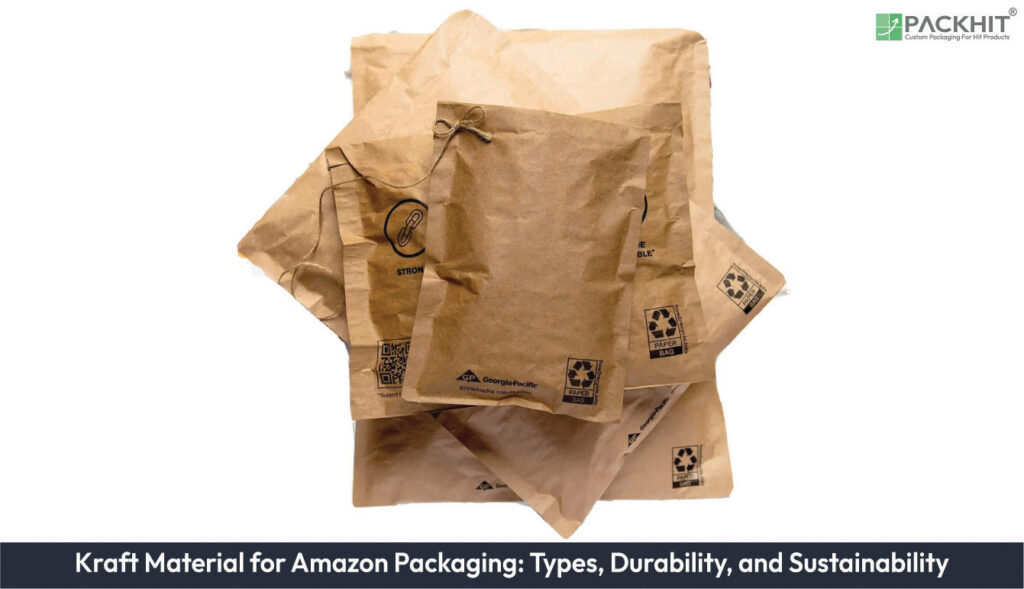Kraft material serves as a foundational element in Amazon’s packaging strategy due to its exceptional blend of strength, cost-effectiveness, and environmental benefits. This paper-based material, derived through the kraft process, is categorized into three primary types: natural kraft paper, known for its durability and affordability; bleached kraft paper, offering enhanced aesthetics for premium packaging; and recycled kraft paper, a sustainable alternative with improved performance metrics. Its durability stems from high tensile strength, tear resistance, and adaptability to moisture or compression challenges, making it ideal for diverse e-commerce applications. Kraft material aligns closely with Amazon’s sustainability goals, featuring renewable sourcing, high recyclability, and biodegradability.
What is Kraft Material for Amazon Packaging?
Kraft material for Amazon packaging refers to a type of paper-based material primarily used for creating durable, cost-effective, and environmentally friendly packaging solutions. It is produced through the kraft process, which involves chemically treating wood pulp to enhance its strength and versatility. Kraft material is commonly utilized in e-commerce applications. Kraft material is the foundation for Amazon’s shipping boxes, mailers, and wrapping paper. Its attributes include high tensile strength, tear resistance, and adaptability to various packaging designs, ensuring optimal protection for products during transit.
What Are the Types of Kraft Material Used in Amazon Packaging?
Amazon employs several types of Kraft material, each tailored to specific packaging requirements. The primary classifications include natural kraft paper, bleached kraft paper, and recycled kraft paper. These variants differ in composition, strength, and aesthetic properties, enabling their use across a range of applications.
Natural Kraft Paper
Natural kraft paper, characterized by its unbleached, brown appearance, is the most commonly used type in Amazon’s packaging. It is produced from virgin wood fibers, which provide high tensile strength and tear resistance. This material is frequently used for shipping boxes, padded mailers, and wrapping paper due to its durability and cost-effectiveness.
Bleached Kraft Paper
Bleached kraft paper undergoes an additional chemical treatment to achieve a white or lighter appearance. While it offers similar strength properties to natural kraft, its aesthetic appeal makes it suitable for premium packaging applications, such as branded envelopes or gift wraps. However, the bleaching process slightly reduces its environmental sustainability compared to unbleached variants.
Recycled Kraft Paper
Recycled kraft paper is manufactured from post-consumer or post-industrial waste, making it a more sustainable option. Although it has slightly lower strength compared to virgin kraft paper, advancements in recycling technology have improved its performance characteristics. This type is often used for filler material, lightweight mailers, and other secondary packaging components.
How Durable is Kraft Material in Amazon Packaging?
The durability of kraft material in Amazon packaging is a function of its fiber composition, basis weight, and structural design. Kraft paper’s inherent strength is derived from the long fibers of softwood trees, which are chemically treated during the kraft process to enhance their bonding and resistance to mechanical stress. Durability is further influenced by environmental factors such as moisture, temperature, and handling conditions.
Tensile Strength and Tear Resistance
Kraft material exhibits high tensile strength, making it resistant to tearing under tension. For example, natural kraft paper with a basis weight of 60-80 gsm (grams per square meter) can withstand significant stress, making it ideal for heavy-duty applications like corrugated boxes. Tear resistance is particularly critical for protecting products during transit, where packaging is subjected to dynamic forces.
Moisture Resistance
While kraft paper is naturally hygroscopic, its moisture resistance can be enhanced through coatings or lamination. Amazon often uses wax-coated or polyethylene-lined kraft material for products requiring additional protection against humidity or liquid exposure. However, these treatments may impact recyclability, necessitating a trade-off between durability and environmental considerations.
Performance Under Compression
Corrugated kraft material, used in Amazon’s shipping boxes, demonstrates excellent compression strength due to its fluted structure. This design distributes weight evenly, preventing deformation under stacking loads. Compression strength is a critical parameter for e-commerce packaging, where boxes are often stacked during storage and transportation.
How Sustainable is Kraft Material in Amazon Packaging?
Kraft material aligns closely with Amazon’s sustainability goals, particularly its Climate Pledge initiative, which aims for net-zero carbon emissions by 2040. The material’s sustainability is evaluated based on its sourcing, recyclability, and end-of-life impact.
Renewable Sourcing
Kraft paper is primarily sourced from sustainably managed forests, where trees are replanted to offset harvesting. The kraft process itself is energy-efficient, utilizing byproducts like lignin to fuel production, thereby reducing reliance on fossil fuels. Certifications such as FSC (Forest Stewardship Council) and PEFC (Programme for the Endorsement of Forest Certification) ensure responsible sourcing practices.
Recyclability and Biodegradability
One of the most significant advantages of kraft material is its high recyclability. Uncoated kraft paper can be recycled up to seven times before fiber degradation limits its usability. Kraft material is biodegradable, decomposing naturally within a few weeks under composting conditions. This minimizes its environmental footprint compared to non-biodegradable alternatives like plastic.
Challenges in Recycling Coated Kraft
While uncoated kraft paper is easily recyclable, coated variants pose challenges. For instance, polyethylene or wax coatings must be separated during the recycling process, which can be resource-intensive. Innovations in water-based coatings and biodegradable laminates are emerging to address these limitations, enhancing the material’s overall sustainability.

